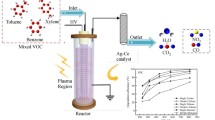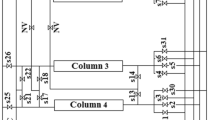Abstract
Degradation of adsorbed toluene over 13X zeolite, 5A molecular sieve and Al2O3 by non-thermal plasma was investigated. Different discharge modes, including closed and ventilated discharge were compared. The carbon balance and COx yield of 13X zeolite were increased by 17.6 and 19.4% by ventilated discharge, respectively, compared with closed discharge. But for 5A molecular sieve and Al2O3, the carbon balance and COx yield by closed discharge were greater than those by ventilated discharge. It meant that the closed discharge was more suitable for low-concentration of VOC and the residence time of reactants would be prolonged. Removal of high-concentration VOC by ventilated discharge was more appropriate because of more reactive oxygen species generated. Furthermore, the effect of discharge background gas was studied. Removal of adsorbed toluene over Co/13X by oxygen and air with different flow rate as background gas were compared. The removal efficiency was reduced as flow rate of background gas increased. The oxygen-discharge was more efficiency for toluene oxidation and inhibited the generation of nitrogen oxides.











Similar content being viewed by others
References
Liu YP, Chen JC, Li W, Shen DK, Zhao YJ, Pal M, Yu HJ, Tu B, Zhao DY (2016) Carbon functionalized mesoporous silica-based gas sensors for indoor volatile organic compounds. J Colloid Interface Sci 477:54–63
Wang BW, Chi CM, Xu M, Wang C, Meng DJ (2017) Plasma-catalytic removal of toluene over CeO2–MnOX catalysts in an atmosphere dielectric barrier discharge. Chem Eng J 322:679–692
Jin M, Zhang XT, Pu HT, Nishimoto S, Murakami T, Fujishima A (2011) Photochromism-based detection of volatile organic compounds by W-doped TiO2 nanofibers. J Colloid Interface Sci 362:188–193
Guo YF, Liao XB, He JH, Ou WJ, Ye DQ (2010) Effect of manganese oxide catalyst on the dielectric barrier discharge decomposition of toluene. Catal Today 153:176–183
Chen J, Xie ZM, Tang JH, Zhou J, Lu XT, Zhao HT (2016) Oxidation of toluene by dielectric barrier discharge with photo-catalytic electrode. Chem Eng J 284:166–173
Jiang LY, Li H, Chen JM, Zhang D, Cao SL, Ye JX (2016) Combination of non-thermal plasma and biotrickling filter for chlorobenzene removal. J Chem Technol Biotechnol 91:3079–3087
Dan N, Jamal HH, Zailina H, Faridah A (2017) Volatile organic compounds (VOC), formaldehyde and nitrogen dioxide (NO2) in schools in Johor Bahru, Malaysia: associations with rhinitis, ocular, throat and dermal symptoms, headache and fatigue. Sci Total Environ 592:153–160
Yi HH, Yang X, Tang XL, Zhao SZ, Wang JG, Cui XX (2017) Removal of toluene from industrial gas over 13X zeolite supported catalysts by adsorption–plasma catalytic process. J Chem Technol Biotechnol 92:2276–2286
Xin L, Sun YB, Feng JW (2016) Ag3PO4/TiO2-assisted degradation of malachite green in aqueous solution treated by dielectric barrier discharge plasma. J Chem Technol Biotechnol 91:2131–2142
Liang WJ, Ma L, Liu H, Li J (2013) Toluene degradation by non-thermal plasma combined with a ferroelectric catalyst. Chemosphere 92:1390–1395
Byeon JH, Park JH, Jo YS, Yoon YK, Hwang JH (2010) Removal of gaseous toluene and submicron aerosol particles using a dielectric barrier discharge reactor. J Hazard Mater 175:417–422
Zhang J, Duan YF, Zhou Q, Zhu C, She M, Ding WK (2016) Adsorption removal of gas-phase mercury by oxygen non-thermal plasma modified activated carbon. Chem Eng J 294:281–289
Sultana S, Vandenbroucke A, Leys C, Geyter ND, Morent R (2015) Abatement of VOCs with alternate adsorption and plasma-assisted regeneration: a review. Catalysts 5:718–746
Kim HH, Ogata A, Futamura S (2008) Oxygen partial pressure-dependent behavior of various catalysts for the total oxidation of VOCs using cycled system of adsorption and oxygen plasma. Appl Catal B Environ 79:356–367
Qin CH, Huang XM, Dang XQ, Huang JY, Teng JJ, Kang ZL (2016) Toluene removal by sequential adsorption–plasma catalytic process: effects of Ag and Mn impregnation sequence on Ag–Mn/γ-Al2O3. Chemosphere 162:125–130
Dang XQ, Qin CH, Huang JY, Teng JJ, Huang XM (2016) Adsorbed benzene/toluene oxidation using plasma driven catalysis with gas circulation: elimination of the byproducts. J Ind Eng Chem 37:366–371
Shi Y, Shao ZH, Shou TY, Tian RB, Jiang JQ, He Y (2016) Abatement of gaseous xylene using double dielectric barrier discharge plasma with in situ UV light: operating parameters and byproduct analysis. Plasma Chem Plasma Process 36:1501–1515
Chen J, Davidson JH (2002) Ozone production in the positive DC corona discharge: model and comparison to experiments. Plasma Chem Plasma Process 22:495–522
Harling AM, Glover DJ, Whitehead JC, Zhang K (2009) The role of ozone in the plasma-catalytic destruction of environmental pollutants. Appl Catal B Environ 90:157–161
Liu SY, Mei DH, Wang L, Tu X (2017) Steam reforming of toluene as biomass tar model compound in a gliding arc discharge reactor. Chem Eng J 307:793–802
Yi HH, Yang X, Tang XL, Zhao SZ, Xie XZ, Feng TC, Ma YQ, Cui XX (2017) Performance and pathways of toluene degradation over Co/13X by different processes based on non-thermal plasma. Energy Fuels 31(10):11217–11224
Qin CH, Dang XQ, Huang JY, Teng JJ, Huang XM (2016) Plasma-catalytic oxidation of adsorbed toluene on Ag–Mn/γ-Al2O3: comparison of gas flow-through and gas circulation treatment. Chem Eng J 299:85–92
Savita KPV, Christophe L, Nathalie DG, Rina M (2017) Abatement of VOCs using packed bed non-thermal plasma reactors: a review. Catalysts 7:113. https://doi.org/10.3390/catal7040113
Einaga H, Ibusuki T, Futamura S (2001) Performance evaluation of a hybrid system comprising silent discharge plasma and manganese oxide catalysts for benzene decomposition. IEEE Trans Ind Appl 37:1476–1482
Xu XX, Wu JL, Xu WC, He ML, Fu ML, Chen LM, Zhu AM, Ye DQ (2017) High-efficiency non-thermal plasma-catalysis of cobalt incorporated mesoporous MCM-41 for toluene removal. Catal Today 281:527–533
Yan J, Wei T, Qiao WM, Shao B, Zhao QK, Zhang LJ, Fana ZJ (2010) Rapid microwave-assisted synthesis of graphene nanosheet/Co3O4 composite for supercapacitors. Electrochim Acta 55:6973–6978
Li CC, Yin XM, Wang TH, Zeng HC (2009) Morphogenesis of highly uniform CoCO3 submicron crystals and their conversion to mesoporous Co3O4 for gas-sensing applications. Chem Mater 21:4984–4992
Andrzej S, Pakula M, Biniak S, Mariusz W (2004) Influence of the surface chemistry of modified activated carbon on its electrochemical behaviour in the presence of lead(II) ions. Carbon 42:3057–3069
Anthony R, Jean MT, Elodie F (2016) Operando DRIFT spectroscopy characterization of intermediate species on catalysts surface in VOC removal from air by non-thermal plasma assisted catalysis. Plasma Chem Plasma Process 36:901–915
Harling AM, Demidyuk V, Fischer SJ, Whitehead JC (2008) Plasma-catalysis destruction of aromatics for environmental clean-up: effect of temperature and configuration. Appl Catal B Environ 82:180–189
Zhu T, Chen R, Xia N, Li XY, He XX, Zhao WJ, Carr T (2015) Volatile organic compounds emission control in industrial pollution source using plasma technology coupled with F-TiO2/Υ-Al2O3. Environ Technol 36:1405–1413
Hadjiivanov KI (2000) Identification of neutral and charged NxOy surface species by IR spectroscopy. Catal Rev 42:71–144
Sivachandiran L, Thevenet F, Rousseau A (2015) Isopropanol removal using MnXOY packed bed non-thermal plasma reactor: comparison between continuous treatment and sequential sorption/regeneration. Chem Eng J 270:327–335
Michel O, Wafa H, Jonathan O, Timea B, Evelyne G (2017) Non-thermal plasma for indoor air treatment: toluene degradation in a corona discharge at ppbv levels. Chem Eng Res Des 118:194–205
Xia DH, Li ZY, Xie YL, Zhang XR (2016) Kinetic simulations of volatile organic compounds decomposition by non-thermal plasma treatment. Water Air Soil Pollut 227:463
Bahri M, Haghighat F, Rohani S, Kazemian H (2016) Impact of design parameters on the performance of non-thermal plasma air purification system. Chem Eng J 302:204–212
Durme JV, Dewulf J, Sysmans W, Leys C, Langenhove HV (2007) Abatement and degradation pathways of toluene in indoor air by positive corona discharge. Chemosphere 68:1821–1829
Acknowledgements
This work was supported by the Program for New Century Excellent Talents in University (NCET-12-0776); the National Natural Science Foundation of China (2150-7004); and the Fundamental Research Funds for the Central Universities (FRF-TP-15-046A1).
Author information
Authors and Affiliations
Corresponding author
Rights and permissions
About this article
Cite this article
Yi, H., Yang, X., Tang, X. et al. Removal of Toluene from Industrial Gas by Adsorption–Plasma Catalytic Process: Comparison of Closed Discharge and Ventilated Discharge. Plasma Chem Plasma Process 38, 331–345 (2018). https://doi.org/10.1007/s11090-017-9863-1
Received:
Accepted:
Published:
Issue Date:
DOI: https://doi.org/10.1007/s11090-017-9863-1




